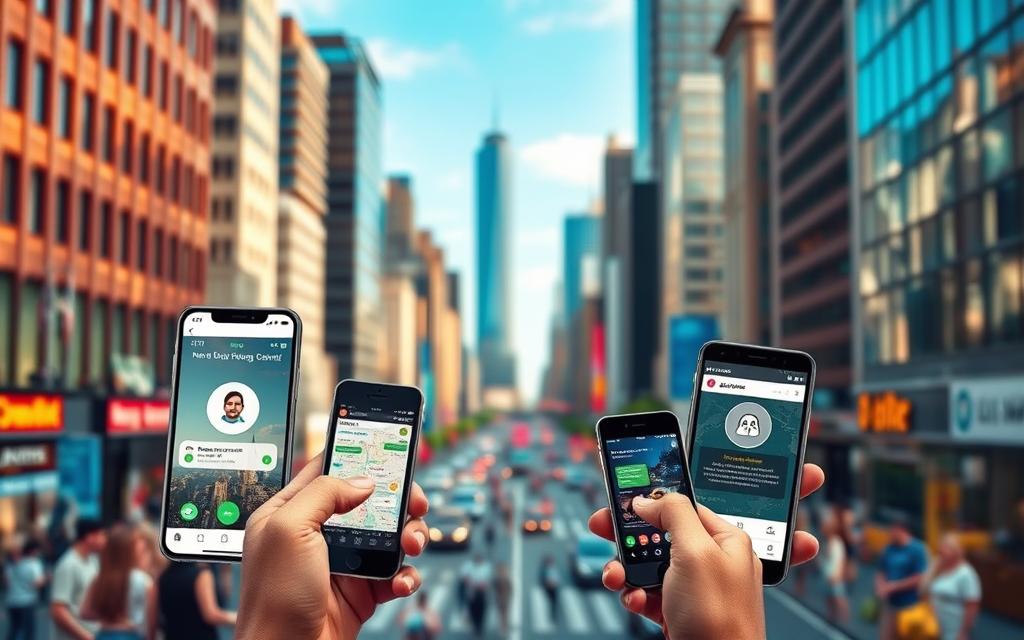Artificial intelligence has become an integral part of our daily lives, often in ways we don’t even realize. From simplifying tasks to enhancing our experiences, artificial intelligence is woven into the fabric of many applications we use every day.
Many of us interact with machine learning and AI applications daily, often without even knowing it. These technologies are not just for the future; they’re already here, making our lives easier and more convenient.
As we explore the world of artificial intelligence, we’ll discover how it’s being used in various apps that are part of our daily routines. Let’s take a closer look at some examples that illustrate how everyday ai examples are changing the way we live and interact with technology.
The Quiet Revolution: How AI Has Already Infiltrated Your Daily Life
Artificial intelligence is no longer just a concept of the future; it’s a reality that’s already influencing our daily routines. The notion that AI is something we’ll encounter in the years to come is a misconception.
The Misconception of AI as Future Technology
Many believe AI is a technology reserved for the future, but the truth is that it’s already here, subtly enhancing our lives. This misunderstanding stems from the lack of overt AI features in our daily apps and services.
The Reality of AI’s Current Integration
AI is currently being used in various applications, from social media algorithms to email services. Its integration is seamless, making it almost invisible to the average user.
Statistics on AI Adoption in Common Applications
According to recent statistics, over 77% of devices utilize AI in some form, whether it’s through virtual assistants or personalized recommendations. This widespread adoption underscores AI’s role in our daily lives.

The presence of AI in everyday life is more significant than we often acknowledge. As technology continues to evolve, we can expect AI’s influence to grow, making it an integral part of our routines.
AI Isn’t Just for the Future: 5 Apps You Use Today Without Knowing It
AI has become an invisible companion in our digital lives, powering numerous apps that we use daily without us even realizing it. The integration of artificial intelligence in these applications has significantly enhanced their functionality and user experience.
The Invisible Integration of Artificial Intelligence
Many popular apps have AI embedded in their core functionality. For instance, social media platforms use AI to curate content, while navigation apps rely on it to predict traffic patterns and suggest the most efficient routes.
Why Companies Don’t Advertise Their AI Usage
Companies often don’t highlight their use of AI because it has become a standard expectation in app development. The focus remains on the benefits and features that AI enables, rather than the technology itself.
The “Magic” Behind the Scenes
The real magic happens behind the scenes where AI algorithms work tirelessly to analyze data, learn from it, and make predictions or decisions that enhance the app’s functionality.

| App | AI Functionality |
|---|---|
| Content curation and personalized ads | |
| Google Maps | Traffic prediction and route optimization |
| Netflix | Content recommendation engine |
| Siri/Google Assistant | Voice recognition and response |
| Spotify | Music recommendation and playlist curation |
Social Media Algorithms: The AI That Knows You Better Than You Know Yourself
The AI algorithms driving social media platforms have become incredibly adept at understanding our preferences and serving us content that we’re likely to engage with. This level of personalization is made possible by complex machine learning models that analyze our interactions, such as likes, shares, and comments.

Facebook and Instagram’s Content Recommendation Systems
Facebook and Instagram use AI to curate content for their users. By analyzing user behavior, these platforms can predict what content is most likely to engage us, making our feeds more relevant and interesting.
TikTok’s Eerily Accurate “For You” Page
TikTok’s “For You” page is a prime example of AI-driven content curation. The algorithm learns our preferences by tracking how we interact with videos, serving us content that’s likely to resonate with us.
Twitter’s Timeline Curation
Twitter also employs AI to curate our timelines, prioritizing tweets that are most likely to engage us. This ensures that we see the most relevant content from accounts we interact with frequently.
How These Algorithms Learn Your Preferences
These social media algorithms learn our preferences by analyzing our interactions, such as likes, shares, and comments. By understanding how we engage with content, they can predict what we’ll like to see in the future, making our social media experiences more personalized and engaging.
The use of AI in social media is a prime example of smart technology in action, enhancing our daily lives by providing us with relevant content and connections.
Email Services: AI Working Behind Your Inbox
Behind the scenes of your email inbox, AI is hard at work, streamlining your communication and enhancing your productivity. Email services like Gmail and Outlook have integrated AI to make managing emails more efficient.
Smart Features in Gmail
Gmail’s Smart Compose feature uses AI to predict and complete sentences as you type, saving time and reducing typing effort. Additionally, Gmail’s Smart Reply suggests quick responses to emails, making it easier to manage your inbox.
Outlook’s AI-Driven Organization
Outlook’s Focused Inbox uses machine learning to categorize your emails, separating important messages from less critical ones. This feature helps you focus on the emails that matter most, improving your productivity.
Spam Filtering Through Machine Learning
Both Gmail and Outlook employ advanced machine learning algorithms to filter out spam emails, ensuring your inbox remains clutter-free. This AI-driven spam filtering is highly effective in blocking unwanted emails.
The Evolution of Email Intelligence
The integration of AI in email services has significantly evolved over the years, from basic spam filtering to complex features like predictive text and email categorization. As AI technology continues to advance, we can expect even more sophisticated email management features in the future.

Navigation Apps: AI Calculating Your Best Route
AI has transformed navigation apps into personal travel assistants, enhancing our daily commutes. With the ability to process vast amounts of data, these apps provide the most efficient routes, real-time traffic updates, and even predict future traffic patterns.
Google Maps and Waze Traffic Predictions
Google Maps and Waze are pioneers in using AI for traffic prediction. They analyze historical traffic data, real-time updates, and even user reports to predict traffic congestion and suggest alternative routes.
Uber and Lyft’s ETA Calculations
Uber and Lyft use AI to estimate arrival times more accurately. By analyzing traffic patterns, road conditions, and the number of available drivers, they provide users with reliable ETAs.
Apple Maps’ Location-Based Suggestions
Apple Maps offers location-based suggestions, thanks to AI. It learns users’ frequent locations and suggests routes based on their habits and preferences.
How AI Processes Millions of Data Points for Your Commute
AI processes data from various sources, including GPS, traffic cameras, and user feedback, to optimize your commute. This complex process involves analyzing millions of data points to predict traffic and suggest the best routes.
| Navigation App | AI Feature | Benefit |
|---|---|---|
| Google Maps | Traffic Predictions | Avoids Congested Routes |
| Waze | Real-time Updates | Provides Alternative Routes |
| Uber/Lyft | ETA Calculations | Accurate Arrival Times |
| Apple Maps | Location-Based Suggestions | Personalized Routes |
By leveraging AI, navigation apps have become indispensable tools for daily commutes, making travel faster, more efficient, and less stressful.
Streaming Services: AI Curating Your Entertainment
Streaming services have become an integral part of our daily entertainment, and AI plays a crucial role in personalizing our viewing and listening experiences. These platforms use complex algorithms to understand user behavior and preferences, suggesting content that is likely to engage them.
Netflix’s Recommendation Engine
Netflix is a pioneer in using AI for content curation. Its recommendation engine analyzes user viewing history, ratings, and search queries to suggest TV shows and movies. This not only enhances user experience but also increases engagement and retention.
Spotify’s Discover Weekly and Daily Mixes
Spotify leverages AI to create personalized playlists like Discover Weekly and Daily Mixes. These playlists are generated based on users’ listening habits, favorite artists, and genres, introducing them to new music they might enjoy.
YouTube’s “Up Next” Suggestions
YouTube uses AI to power its “Up Next” feature, suggesting videos based on what users have watched previously. This keeps users engaged for longer periods, making it a powerful tool for content creators and advertisers alike.
The Business of Keeping You Engaged
The use of AI in streaming services is not just about enhancing user experience; it’s also a business strategy. By keeping users engaged, these platforms can increase their subscription base and advertising revenue. The table below highlights how different streaming services use AI to their advantage.
| Streaming Service | AI Feature | Benefit |
|---|---|---|
| Netflix | Personalized Recommendations | Increased User Engagement |
| Spotify | Discover Weekly, Daily Mixes | New Music Discovery |
| YouTube | “Up Next” Suggestions | Longer User Sessions |
By understanding and leveraging AI, streaming services continue to evolve, offering users a more personalized and engaging experience. As AI technology advances, we can expect these services to become even more intuitive and user-friendly.
Smartphone Features: AI in Your Pocket
With AI, your smartphone is not just a tool, but a companion that learns and adapts to your needs. The integration of Artificial Intelligence into smartphones has revolutionized the way we interact with our devices, making them more intuitive and personalized.
Facial Recognition and Photo Organization
One of the most notable AI features in smartphones is facial recognition. This technology allows for secure unlocking and can organize your photos based on the people in them, making it easier to find specific pictures. It’s an example of “everyday ai” that simplifies daily tasks.
Voice Assistants Like Siri and Google Assistant
Voice assistants are another prime example of AI in action. Siri and Google Assistant can perform tasks, answer questions, and even predict your needs based on your usage patterns. They embody the concept of “popular ai applications” that have become integral to our daily routines.
Predictive Text and Autocorrect Functionality
AI-driven predictive text and autocorrect have significantly improved the typing experience on smartphones. These features learn your typing habits and suggest corrections, making communication faster and more accurate.
Battery Optimization and Performance Management
AI also plays a crucial role in managing your smartphone’s battery life and performance. By analyzing your usage patterns, AI can optimize background processes, limit battery-draining apps, and ensure that your device runs smoothly.
These AI-powered features demonstrate how “essential ai in daily life” has become, enhancing our smartphone experience and making it more efficient. As AI continues to evolve, we can expect even more innovative applications in the future.
Embracing the AI-Enhanced Present
As we’ve explored throughout this article, AI is no longer just a futuristic concept; it’s a reality that’s already deeply ingrained in our daily lives. From social media algorithms to navigation apps, AI is working behind the scenes to make our lives easier and more convenient. The technology in daily life is transforming the way we interact, work, and play.
Common AI apps like Facebook, Google Maps, and Netflix are just a few examples of how AI integration in everyday apps is enhancing our experiences. Whether it’s through personalized recommendations or streamlined processes, AI usage in daily technology is revolutionizing the way we live. As we move forward, it’s clear that AI will continue to play an increasingly important role in shaping our world.
By embracing this AI-enhanced present, we can look forward to a future where technology continues to innovate and improve our lives. As AI continues to evolve, it’s exciting to think about the new possibilities and opportunities that will arise. With AI isn’t just for the future, but a reality that’s already here, we can harness its potential to create a brighter, more efficient tomorrow.




